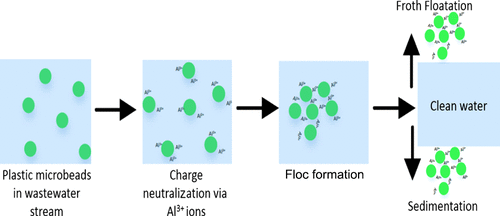Our official English website, www.x-mol.net, welcomes your feedback! (Note: you will need to create a separate account there.)
Removal of Microbeads from Wastewater Using Electrocoagulation
ACS Omega ( IF 4.1 ) Pub Date : 2018-03-20 00:00:00 , DOI: 10.1021/acsomega.7b02037 William Perren 1 , Arkadiusz Wojtasik 1 , Qiong Cai 1
ACS Omega ( IF 4.1 ) Pub Date : 2018-03-20 00:00:00 , DOI: 10.1021/acsomega.7b02037 William Perren 1 , Arkadiusz Wojtasik 1 , Qiong Cai 1
Affiliation

|
The need for better microplastic removal from wastewater streams is clear, to prevent potential harm the microplastic may cause to the marine life. This paper aims to investigate the efficacy of electrocoagulation (EC), a well-known and established process, in the unexplored context of microplastic removal from wastewater streams. This premise was investigated using artificial wastewater containing polyethylene microbeads of different concentrations. The wastewater was then tested in a 1 L stirred-tank batch reactor. The effects of the wastewater characteristics (initial pH, NaCl concentration, and current density) on removal efficiency were studied. Microbead removal efficiencies in excess of 90% were observed in all experiments, thus suggesting that EC is an effective method of removing microplastic contaminants from wastewater streams. Electrocoagulation was found to be effective with removal efficiencies in excess of 90%, over pH values ranging from 3 to 10. The optimum removal efficiency of 99.24% was found at a pH of 7.5. An economic evaluation of the reactor operating costs revealed that the optimum NaCl concentration in the reactor is between 0 and 2 g/L, mainly due to the reduced energy requirements linked to higher water conductivity. In regard to the current density, the specific mass removal rate (kg/kWh) was the highest for the lowest tested current density of 11 A/m2, indicating that low current density is more energy efficient for microbead removal.
中文翻译:

使用电凝去除废水中的微珠
很明显,需要从废水中去除更好的微塑料,以防止微塑料可能对海洋生物造成潜在的伤害。本文旨在研究电凝(EC)的功效,这是在未开发的从废水中去除微塑料的未探索背景下的众所周知的既定方法。使用包含不同浓度的聚乙烯微珠的人工废水对这一前提进行了研究。然后在1 L搅拌釜分批反应器中测试废水。研究了废水特性(初始pH,NaCl浓度和电流密度)对去除效率的影响。在所有实验中观察到微珠去除效率均超过90%,因此表明EC是一种从废水流中去除微塑性污染物的有效方法。发现电凝在pH值在3到10范围内的去除效率超过90%时是有效的。在pH值为7.5时,发现最佳的去除效率为99.24%。对反应器运行成本的经济评估表明,反应器中的最佳NaCl浓度在0至2 g / L之间,这主要是由于与更高的水电导率相关的能源需求降低。关于电流密度,单位质量去除率(kg / kWh)最高,而最低测试电流密度为11 A / m 对反应器运行成本的经济评估表明,反应器中的最佳NaCl浓度在0至2 g / L之间,这主要是由于与更高的水电导率相关的能源需求降低。关于电流密度,单位质量去除率(kg / kWh)最高,而最低测试电流密度为11 A / m 对反应器运行成本的经济评估表明,反应器中的最佳NaCl浓度在0至2 g / L之间,这主要是由于与更高的水电导率相关的能源需求降低。关于电流密度,单位质量去除率(kg / kWh)最高,而最低测试电流密度为11 A / m如图2所示,表明低电流密度对于微珠去除更节能。
更新日期:2018-03-20
中文翻译:

使用电凝去除废水中的微珠
很明显,需要从废水中去除更好的微塑料,以防止微塑料可能对海洋生物造成潜在的伤害。本文旨在研究电凝(EC)的功效,这是在未开发的从废水中去除微塑料的未探索背景下的众所周知的既定方法。使用包含不同浓度的聚乙烯微珠的人工废水对这一前提进行了研究。然后在1 L搅拌釜分批反应器中测试废水。研究了废水特性(初始pH,NaCl浓度和电流密度)对去除效率的影响。在所有实验中观察到微珠去除效率均超过90%,因此表明EC是一种从废水流中去除微塑性污染物的有效方法。发现电凝在pH值在3到10范围内的去除效率超过90%时是有效的。在pH值为7.5时,发现最佳的去除效率为99.24%。对反应器运行成本的经济评估表明,反应器中的最佳NaCl浓度在0至2 g / L之间,这主要是由于与更高的水电导率相关的能源需求降低。关于电流密度,单位质量去除率(kg / kWh)最高,而最低测试电流密度为11 A / m 对反应器运行成本的经济评估表明,反应器中的最佳NaCl浓度在0至2 g / L之间,这主要是由于与更高的水电导率相关的能源需求降低。关于电流密度,单位质量去除率(kg / kWh)最高,而最低测试电流密度为11 A / m 对反应器运行成本的经济评估表明,反应器中的最佳NaCl浓度在0至2 g / L之间,这主要是由于与更高的水电导率相关的能源需求降低。关于电流密度,单位质量去除率(kg / kWh)最高,而最低测试电流密度为11 A / m如图2所示,表明低电流密度对于微珠去除更节能。



























 京公网安备 11010802027423号
京公网安备 11010802027423号